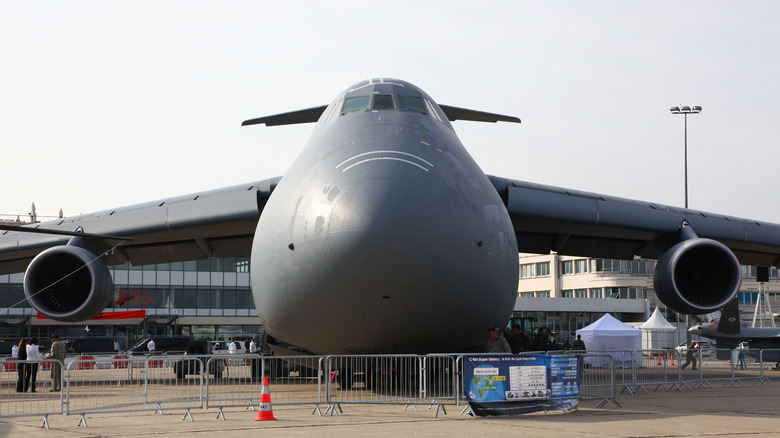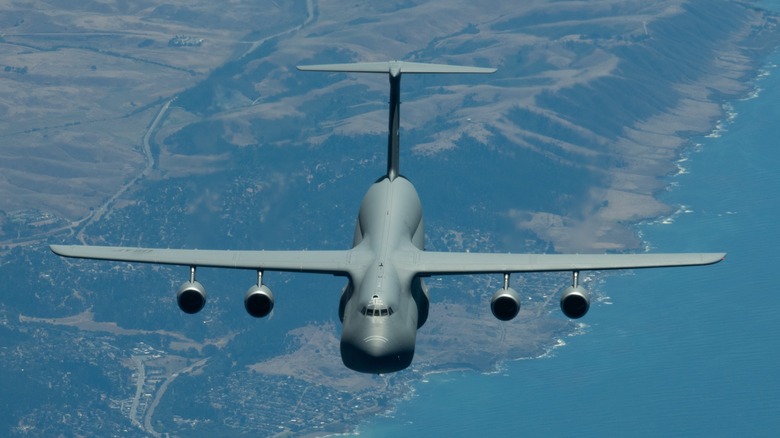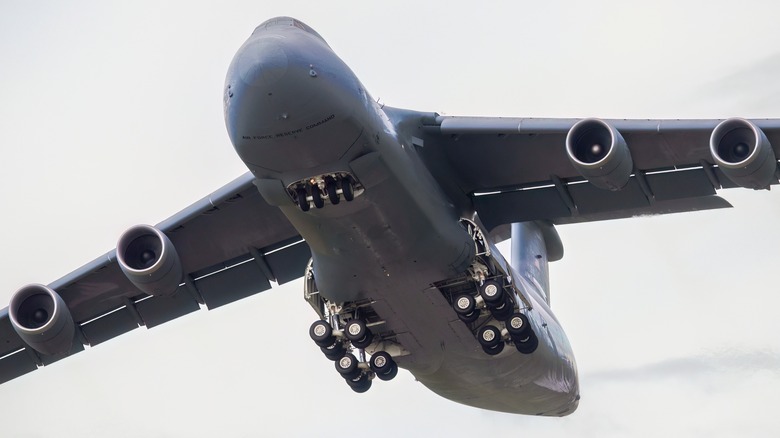
Fingerhut/Shutterstock
The United States has certainly developed a reputation as a big military spender. The world’s biggest, in fact, with Statista noting that the total U.S. military expenditure in 2023 was $916 billion (China came second with $296 billion). It would be reasonable to expect some proportionally large hardware to result from that enormous expenditure.
Advertisement
The U.S. Air Force has certainly had some supersized aircraft in its ranks over the years. Take the C-130 Hercules, a gargantuan U.S. Air Force transport plane with a 132.7 feet wingspan and a maximum weight of 164,000 pounds in its C-130J guise, tailored for airlift missions. The Hercules was the biggest aircraft ever to land on an aircraft carrier, but the force’s current biggest aircraft is a different monstrously large transport aircraft: The C-5M Super Galaxy that would follow in Hercules’ vast footsteps.
The Super Galaxy, from veteran makers of great jets at Lockheed Martin, resulted from an intense process of modernization performed on the original C-5 Galaxy. The original was itself introduced during the Cold War as a means of transporting ferocious – and hefty – new weaponry like the 50-ton M60 tank. After all, during such a time, it was difficult to predict where a threat may arise from and when, and so for swift deployment’s sake, it might be crucial to be able to transport such heavy cargo great distances quickly.
Advertisement
The sheer scale of the C-5M Super Galaxy

Aqeela_Image/Shutterstock
The modified and improved model of the Galaxy that would be named the Super Galaxy began appearing in the mid-2000s, with the second of them taking flight in November 2006. At the time, Lockheed Martin C-5 Modernization vice president George Shultz dubbed the project «a true recapitalization program for a critical capability, ensuring a viable strategic airlift resource for America through the year 2040.»
Advertisement
It was quite a statement of intent, and one that makes it clear that the company had great faith in the aircraft’s capacity to do one vital thing: to provide significant load-carrying capacity for the foreseeable future. There’s really no such thing as being future proof in the world of aviation, but the Super Galaxy, even in this early test flight period, had two very important virtues to note: it was both enormous and enormously powerful.
It boasts a quartet of General Electric engines, F-138-GE100s, offering 51,250 pounds of thrust apiece. They could propel the model to a considerable range, too: unencumbered, its range tops out at 7,000 nautical miles. It was a considerable step above the capacities of the original 1968 Galaxy, which could muster 41,000 pounds of thrust and a range of 3,700 miles when fully loaded. Its powerplant is the TF39-GE-1C turbofan engine, also by General Electric. The most significant upgrade of the Super Galaxy, perhaps, is the extra cargo capacity and how it’s utilized.
Advertisement
The Super Galaxy’s supersized carrying capacity

Karolis Kavolelis/Shutterstock
The original Galaxy was created to replace predecessors like the C-130 Hercules. Another Lockheed Martin aircraft, Hercules debuted in 1956. It was certainly Herculean at the time, with the C-130A measuring almost 98 feet long and with a 132 ft 7 in wingspan, and it also sported a quartet of engines: T56-A-1A turboprops this time. With a speed of up to 383 mph and a weight of 108,000 lbs with its cargo, though, it didn’t meet U.S. military demands of the following decade.
Advertisement
Hercules underwent decades of development and new models, with the C-130J Super Hercules – debuting in 1996 – offering 44,000 lbs of cargo storage and a range of 2,100 nautical miles when carrying a load. The mighty Super Galaxy, however, remains much larger. Lockheed Martin boasts that the model has a 20% larger capacity than the original, and its maximum cargo of an astonishing 281,001 pounds – with a takeoff weight topping out at 840,000 pounds – proves what a heavy lifter it is.
With a wingspan of 222 feet 9 inches and length of almost 250 feet (143 feet 9 inches of which being the cargo storage area), it’s a behemoth. It was also designed with practicality in mind: «Both the nose and aft doors open, allowing ground crews to simultaneously load and off-load cargo from both ends, reducing cargo transfer times,» reports the United States Air Force, and it also offers in-air refueling.
Advertisement